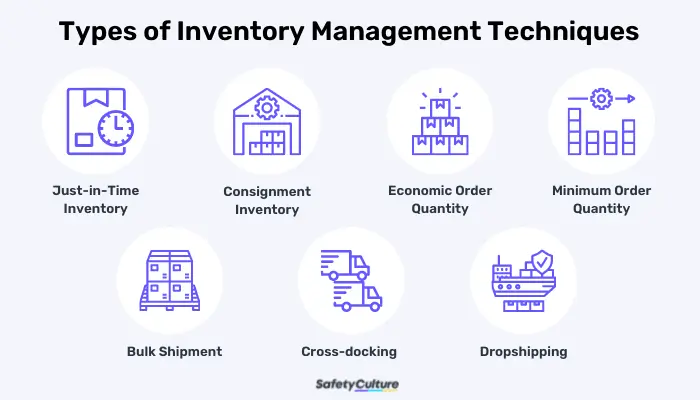What are Inventory Management Techniques?
Inventory management techniques consist of methods and strategies for effectively ordering, using, and storing items on stock. Finding the right method will depend on the kind of product or business that your company puts forward. Establishing an effective inventory management system helps significantly decrease carrying costs and sustain a well-oiled supply chain.
Importance of Inventory Management Techniques
Employing the right tools and techniques in inventory management offers plenty of benefits for your business. For instance, these methods allow you to improve your inventory processes and reduce storage costs. Keeping your stocked items to an optimal level lets you save warehouse space and rental expenses.
Effective inventory management techniques also enable you to serve your customers better. Stocking up on the goods ensures that you can deliver your products more quickly and, in turn, meet consumer demands.
Aside from this, managers handling multiple inventories can also perform their duties more effectively using inventory management methods that suit their business needs.
Types of Inventory Management Techniques
Inventory management affects all aspects of your business operations—from production to distribution. Thus, it’s vital to select the right tools to manage your stocks effectively. This section explores seven inventory management techniques, including their benefits and costs.

Types of Inventory Management Techniques
Just-in-Time Inventory
The Just-in-Time (JIT) inventory traces its roots to the Toyota manufacturing system. This inventory management technique involves holding minimal stock levels in the right amount and time. Implementing this system requires careful planning for the timely delivery of new orders.
Pros: By keeping stock levels to a minimum, companies can avoid excess amounts of inventory that could remain unattended in the warehouse. It also helps reduce waste and save rent and warehouse costs.
Cons: Even the tiniest delays can cause issues, so executing this system must be thoroughly planned. Without a proper plan, it puts businesses at risk of having stockouts.
Bulk Shipment
This inventory management technique runs under the premise that purchasing and shipping goods in bulk are cheaper. Bulk shipment is ideal for staple goods with high customer demand and long shelf life. However, this method can pose a problem when used in products with fluctuating demands.
Pros: Delivering items in large quantities reduces the number of shipments needed. In turn, it helps save up on shipping costs. Moreover, it also increases the potential for profitability, especially for in-demand inventory items.
Cons: On the flip side, bulk shipment also elevates the potential risk on a company’s capital. Companies might also find it challenging to adjust when the demand changes without notice. Moreover, holding large inventory amounts can drive up storage and warehousing costs.
Consignment Inventory
Typically, a retailer buys goods from a supplier first before selling them to the public. However, this transaction takes a different route under a consignment inventory.
In this approach, the consignor (supplier) allows the consignee (retailer) to sell goods without paying upfront. The supplier still owns the product but places the responsibility on keeping and selling them to the retailer. Consequently, the retailer pays the supplier only after selling the products.
Pros: On the supplier side, having a consignment agreement results in lower storage costs. Moreover, handing over the products to the retailer opens their products to a larger market without taking up too much space in their warehouse.
Meanwhile, retailers can offer goods without typing them up to their capital. This method also allows them to return unsold items at minimal to no cost.
Cons: The supplier receives no money until the retailer sells their merchandise. Given this, they must have enough cash on hand for extended periods to make up for this. And if the products don’t sell well, both parties will face losses. The supplier might lose capital, while the retailer might lose storage space.
Cross-docking
Cross-docking refers to a system of shipping inventory items from the supplier to the retailer. In this method, suppliers transfer their goods directly to outbound vehicles for shipment. Immediately delivering items to retailers can help cut holding and warehouse costs.
Pros: Cross-docking requires little to no storage space, as the goods are transferred directly into delivery trucks. Thus, businesses no longer need to hold inventory in the warehouse for long periods.
Cons: To carry out this method successfully, you must have an extensive network of transport vehicles at your disposal.
Dropshipping
In contrast, dropshipping allows suppliers to ship goods to their customers directly. When a retailer sells a product, the supplier becomes responsible for delivering it to the customer. This way, retailers can offer products without handling the inventory itself. Dropshipping works best for online stores.
Pros: Dropshipping removes the costs of holding stock items. Since retailers no longer need to worry about storing and fulfilling inventory items, they can focus on selling the products instead.
Cons: Inventory management and quality assurance fall entirely under the responsibility of the supplier.
Economic Order Quantity
Economic Order Quantity (EOQ) identifies how much inventory a company should order at a given time. It computes the number of units or items to purchase with every batch order. By buying the right amount of goods, companies can save warehousing space and minimize overstock costs.
The EOQ formula considers the following factors:
- Setup costs – per order, including handling and shipping
- Demand rate – the number of items sold per year
- Holding costs – determined annually, per unit
Pros: Determining the ideal EOQ significantly reduces ordering, carrying, and other logistical costs. Companies can also tailor this formula to suit their business needs.
Cons: The EOQ formula requires a solid understanding of complex mathematical computations. It also fails to consider economic fluctuations as it assumes a stable demand for goods.
Minimum Order Quantity
Minimum Order Quantity (MOQ) sets the smallest amount of inventory to buy in each order. The computation is based on the following metrics:
- Monthly product demand
- Break-even point between the total cost and revenue of inventory items
- Estimated holding costs
In other words, it calculates the lowest minimum unit of stock a retailer can order from a supplier. Cheaper items will typically have a higher MOQ since they are more cost-effective. In contrast, expensive goods often have a lower MOQ.
Pros: Setting an MOQ helps suppliers find the best possible price per unit. Keeping purchases to a minimum can help them keep inventory costs low while gaining a steady profit margin.
Cons: The upfront costs for producing units can take a toll, especially on small businesses. Moreover, the calculation only includes production costs without other aspects such as shipments and more.




